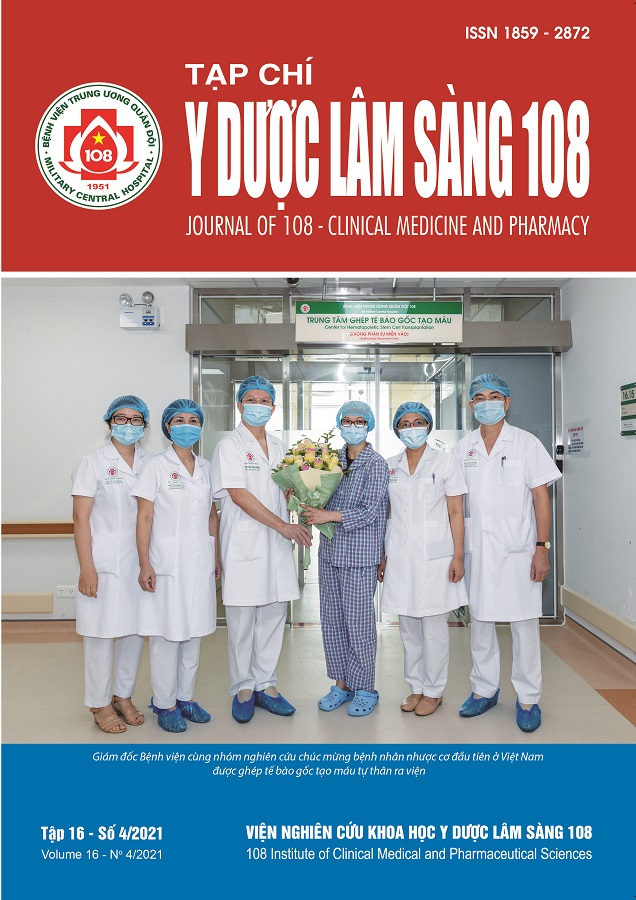Outcome of pancreaticoduodenectomy with lymphadenectomy in treatment of cancers in panceatic head area
Main Article Content
Keywords
Abstract
Objective: To evaluate the surgical outcome and long-term survival of lymphadenectomy during pancreaticoduodenectomy for cancers in pancreatic head area. Subject and method: A prospective, descriptive study on patients with cancer in pancreatic head area who underwent radical operation in 108 Military Central Hospital from July 2016 to July 2019. Result: There were 61 cases with the average age was 60.2 ± 7.7 years, lymphadenectomy was feasible in almost cases. Surgical outcome were good 44.3%, fair 41%, average 11.5% and bad 3.3%. Postoperative complications according to Dindo classification was 55.7% (16.3% servere complication), 39.3% pancreatic fistula, 16.4% intraluminal bleeding, 11.5% abdominal cavity bleeding and 6.6% delayed gastic emptying. Postoperative mortality was 1.6% and postoperative hospital stay was 18.6 ± 7.2 days. The average survival time was 29.98 ± 2.54 months, the 1 and 3-years overall survival rates were 79.2% and 39.5% respectively. Pancreatic adenocarcinoma, radical surgery R1 and lympho node metastasis were prognosis factors for long-term survival. Conclusion: Lymphadenectomy during pancreaticoduodenectomy was acceptably safe and feasible. However, the long-term outcome needed to be improved and its prognosis factors were pancreatic cancer, radical surgery R1 and lympho node metastasis.
Article Details
References
2. Kathleen K. Christians, D.B.E., Sergio Pedrazzoli, Cosimo Sperti, Robert Beaulieu, Frederick Eckhauser, and Kendrick ML (2016) Resection for Neoplasms of the Pancreas. In Atlas of Upper Gastrointestinal and Hepato-PancreatoBiliary Surgery, P.-A. Clavien, Editor., Springer: Verlag Berlin Heidelberg: 831-871.
3. Chen JS et al (2019) Pancreatic fistula after pancreaticoduodenectomy: Risk factors and preventive strategies. Journal of Cancer Research and Therapeutics 15(4): 857.
4. Gao F et al (2016) Risk factors and treatment for hemorrhage after pancreaticoduodenectomy: a case series of 423 patients. Biomed Res Int 2016:2815693.
5. Melloul E et al (2020) Guidelines for Perioperative Care for Pancreatoduodenectomy: Enhanced Recovery After Surgery (ERAS) Recommendations 2019. World journal of surgery: 1-29.
6. Aziz K, Wolfgang CL, and Javed AA (2018) Operative complications and their management following resection for pancreatic and periampullary cancers, in surgery for pancreatic and periampullary cancer. Springer: 227-238.
7. Sperling J et al (2016) Extended versus standard lymphadenectomy in patients undergoing pancreaticoduodenectomy for periampullary adenocarcinoma: A prospective randomized single center trial. European Surgery 48(1): 26-33.
8. He J and Cameron JL (2018) Pancreaticoduodenectomy for Pancreatic Cancer, Short‐and Long‐Term Outcomes After Kausch-Whipple and Pylorus‐Preserving Resection. The Pancreas: An Integrated Textbook of Basic Science, Medicine, and Surgery: 783-789.
9. Wiltberger G et al (2018) Pancreaticoduodenectomy for periampullary cancer: Does the tumour entity influence perioperative morbidity and long-term outcome? Acta Chirurgica Belgica 118(6): 341-347.
10. Zakaria H et al (2020) Prognostic factors for long-term survival after pancreaticoduodenectomy for periampullary adenocarcinoma. A retrospective cohort study. Annals of Medicine and Surgery.
 ISSN: 1859 - 2872
ISSN: 1859 - 2872
